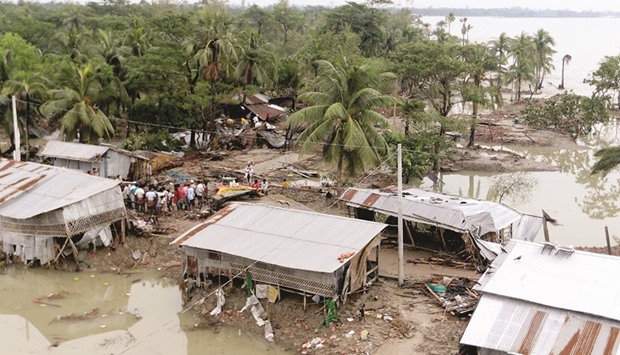A single storm has caused major problems in many parts of South Asia. From Sri Lanka to China, Tropical Cyclone Roanu has brought torrential rain and widespread flooding.
The storm first formed to the east of Sri Lanka, on the leading edge of the monsoon rains. Storms often form in the initial monsoon clouds, so the onset of the monsoon is a particularly hazardous time of year. The storm started to cause problems even before it was classed as a tropical system. It started to bring torrential rain as it drifted slowly north, parallel to the east coast of the island.
As the rain poured, the ground quickly became saturated. Huge puddles started to form that transformed roads into vast rivers and landscapes into lakes. As the waters rose, buildings were inundated and hundreds of thousands of people were forced to leave their homes.
With the weight of the water weighing down on the mountainsides, the soil became unstable and walls of mud began to rip through the countryside. One survivor said it sounded like a plane crash, but when she opened her door, it looked like a huge fireball was rolling down the mountainside.
Entire villages were swallowed by the landslides and there were reports that people were crushed by as much as 15 metres of earth. To make matters worse for the victims, rescue operations were hampered because roads leading to many of the worst hit regions were impassable or highly dangerous.
The flooding and landslides forced hundreds of thousands of people to leave their homes. 200,000 were displaced from Colombo alone. The flood water was so high that people became trapped in the upstairs floors of their homes, or marooned on isolated mounds of dry land.
The rains in Sri Lanka continued for days. It may have been the storm which initially triggered the downpours across the country, but the rains continued even as it moved away.
The storm itself was heading north and still intensifying. The west coast of India was the next in the firing line. One suburb of Chennai, Kelambakkam, reported 226mm of rain from the system. This triggered major flooding, which is unusual at this time of year. Chennai is sheltered from the summer monsoon by the Eastern Ghats mountain range, so May is normally fairly dry. The storm brought almost 10 times the average expected in the entire month.
The storm continued to intensify. It became the region’s first cyclone of the year, and was given the name Roanu. Storms of this nature get their energy from the warmth of sea water. The shallow water along the east coast of India had temperatures reaching 30C in places, which provided plenty of fuel for the cyclone. Fortunately, however, the winds high up in the atmosphere were strong enough to prevent this happening. The winds disrupted the system, effectively trying to push it over. The location of the storm also worked against it, because the outer fringes of it remained over land, and this causes friction which weakened the system.
This ensured that the winds were never the major problem of the storm. Instead, it was the rain that continued to give cause for concern. As Tropical Cyclone Roanu marched steadily along the east coast of India, a number of locations reported between 200 and 300 mm of rain. This is a significant amount of water, which caused significant flooding. Luckily the storm moved steadily along the coast. It was producing so much rain that had it stalled, the flooding would have been disastrous.
After battering the east coast of India, the cyclone then headed towards Bangladesh. This is always a cause for concern, because the shape of the Bay of Bengal naturally encourages storm surges. These walls of water can cause immense devastation, due to the high population density of the region and the fact that much of the land is less than five metres above sea level.
Fortunately Tropical Cyclone Roanu only produced a storm surge of about one metre (three feet). However, this, coupled with the torrential rain, was enough to cause widespread flooding. The cities of Barisal and Chittagong were hit particularly hard, and hundreds of houses were destroyed.
The storm then moved northwards, towards southern China. Once over land, it no longer had access to its energy source, the warm sea waters, so the storm started to die. The winds eased and the rain began to ease.
After battering the region for more than a week, there was an acute sense of relief when the storm fizzled out. However, for Sri Lanka, the process of clearing the mud and drying their homes will take many more weeks. The problem is that the monsoon will bring more heavy rain over the next few months, and this is certain to make the clean-up operation that little bit more difficult.

DESTRUCTIVE: Bangladesh villagers gather around the wreckage of destroyed homes in Chittagong on May 22, after Cyclone Roanu struck the southern coastline. Thousands of Bangladeshis were left homeless after Cyclone Roanu battered the impoverished southern coastal region, ripping apart flimsy houses and killing at least 24 people. Photo by AFP


